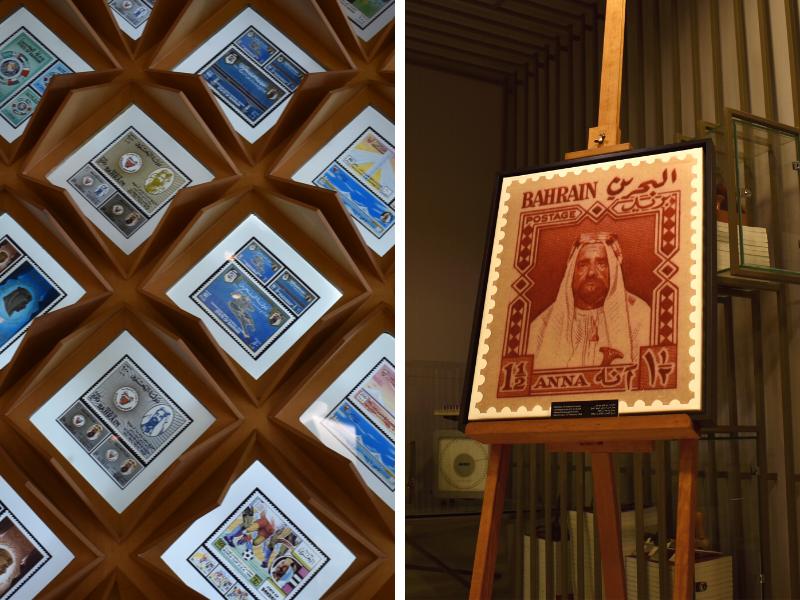By Tamim Almousa (@tumammin)
Postage stamps. Pretty little things, aren’t they? Although, with the advent of the digital age, we don’t see much of them these days. If (like me) you live in Bahrain, there’s a good chance you haven’t received an old-fashioned letter in quite some time. That’s what you get for replacing your mailbox with an inbox. As a result, your chances of ever seeing a stamp (in the flesh) are slim to none. Unless, of course, you pay Manama’s Post Office Museum a visit—in which case you’ll see thousands of them.
The building, though renovated, remains true to its original 1884 form, nestled in between the alleys of Bab Al Bahrain’s Souq, sitting right next to the local police station—a good place for a museum. Don’t, however, let first impressions fool you. Although old-school on the outside, it’s modern and minimalistic inside. Unlike Times Square, for example, that assaults your eyes with retina-burning stimuli. Instead, it maintains a quiet and tranquil aura that beautifully contrasts with the hustle and bustle just outside its doors.


As is the case with most post offices, this one isn’t particularly large. Walk in and very quickly you’ll find yourself in the middle of it, where freestanding cases tower almost as high as the ceiling, each containing prints relevant to GCC countries. From there, you’re free to wander into either of the two rooms that flank the main hall: Postal Items and Cancellations or Stamps of the World.


The aptly named Postal Items and Cancellations room showcases a variety of rubber stamps, press stamps, and other printing paraphernalia. All of which, were from the olden days when only birds tweeted, and snail-mail was referred to as just “mail”. Not too many things to see. After all, the main attraction here is the postage stamp collection. Yet, the sheer volume of it isn’t immediately evident—and for good reason.


In large numbers and laid out all over the place, artifacts and collectibles have a habit of displacing your attention. This will cause you to spend less time looking at one thing lest you miss out on feasting your eyes on the next. That’s often the way with museums: there’s so much to see, you don’t know where to look first. Not here. The majority of the collection is stored in cases disguised as vertical drawers, each labeled by country and tucked into the building’s eastern wall.



If you look hard enough, out in the main hall, you’ll even find old envelopes bearing handwritten addresses and letters that were left behind. But, even here, the postage stamps steal the show.
Curious, isn’t it? What is it about these miniature paintings that make them so special? Why do people collect them? Why are they on display at a museum? Yes, they’re quaint and, if you have enough of them, they sit nicely in a frame. But so would a bunch of daisies or a fistful of bottle caps, and you don’t see those in a museum, do you? I should hope not.



See, initially, postage stamps were introduced to do one thing: serve as proof of payment for mailing services. Do they need to be hauntingly beautiful, painstakingly detailed, and thoughtfully put together to do this simple and dispassionate job? Of course not, but that’s beside the point. Unlike a QR code or receipt, a stamp doesn’t boast about what it does; it’s a reflection of what we do. It celebrates people, marks milestones, and captures the general mood of an era. It’s a snapshot of what we (as a nation) were occupied with during a specific point in time, and a clue to what we held dear and sacred. In short, postage stamps bear representations of what we care about. And that’s why we care about them.


These little thumbnails, then, don’t just look pretty. They make us think and, in some cases, clue us in. My wife, with whom I went to the museum, turned to me on our way out and remarked, “Wow, we were pretty progressive back then,” referring to a women’s rights stamp from the ’70s. Who knew? Well, we did. But only because we went to Manama’s Post Office Museum.
If you haven’t been, I urge you to go. It’s one of Bahrain’s best, and while its valuable and comprehensive collection is priceless, your visit to the museum is free of charge. If you do want to spend some money, the philatelic bureau located on the 1st floor will sell you some stamps.
For more information, visit the Bahrain Authority for Culture and Antiques’ website.






